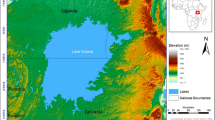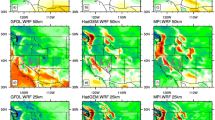Abstract
The effects of increased atmospheric CO2 on the frequency of extreme hydrologic events in the Western United States (WUS) for the 10-yr period of 2040–2049 are examined using dynamically downscaled regional climate change signals. For assessing the changes in the occurrence of hydrologic extremes, downscaled climate change signals in daily precipitation and runoff that are likely to indicate the occurrence of extreme events are examined. Downscaled climate change signals in the selected indicators suggest that the global warming induced by increased CO2 is likely to increase extreme hydrologic events in the WUS. The indicators for heavy precipitation events show largest increases in the mountainous regions of the northern California Coastal Range and the Sierra Nevada. Increased cold season precipitation and increased rainfall-portion of precipitation at the expense of snowfall in the projected warmer climate result in large increases in high runoff events in the Sierra Nevada river basins that are already prone to cold season flooding in today’s climate. The projected changes in the hydrologic characteristics in the WUS are mainly associated with higher freezing levels in the warmer climate and increases in the cold season water vapor influx from the Pacific Ocean.
Similar content being viewed by others
References
Aguado, E., Cayan, D., Riddle, L., and Roos, M.: 1992, ‘Climate fluctuations and the timing of west coast streamflow’, J. Climate 5, 1468–1483.
Cho, H., Niewiadomski, M., and Iribarne, J.: 1989, ‘A model of the effect of cumulus clouds on the redistribution and transformation of pollutants’, J. Geophys. Res 29, 1127–1205.
Davis, H.: 1976, ‘A lateral boundary formulation for multi-level prediction models’, Quart. J. Roy. Meteor. Soc 102, 404–418.
Dettinger, M. D. and Cayan, D. R.: 1995, ‘Large-scale atmospheric forcing of recent trends toward early snowmelt runoff in California’, J. Climate 8, 606–623.
Elliott, W. P., Ross, R. J., and Gaffen, D. J.: 1995, ‘Water Vapor Trends over North America’, in 6th Symposium On Global Change Studies, American Meteorological Society, 185–186, Preprints.
Giorgi, F., Brodeur, C. S., and Bates, G. T.: 1994, ‘Regional climate change scenarios over the United States produced with a nested regional climate model: Spatial and seasonal characteristics’, J. Climate 7, 375–399.
Giorgi, F., Hurrell, J. W., Marinucci, M. R., and Beniston, M.: 1997, ‘Elevation dependency of the surface climate signal: A model study’, J. Climate 10, 288–296.
Goodridge, J. D.: 1994, ‘A study of 1000 year storms in California’, in Predicting Heavy Rainfall Events in California: A Symposium to Share Weather Pattern Knowledge,Sierra College, Rocklin, California, pp. 3–72, Preprints.
Groisman, P. Ya. and Easterling, D. R.: 1994, ‘Variability and trends of precipitation and snowfall over the western United States and Canada’, J. Climate 7, 184–205.
Groisman, P. Ya., Knight, R. W., and Karl, T. R.: 2001, ‘Heavy precipitation and high streamflow in the contiguous United States: Trends in the twentieth century’, Bull. Amer. Meteorol. Soc 82, 219–246.
Harshvardhan, Davis, R., Randall, D., and Corsetti, T.: 1987, ‘A fast radiation parameterization scheme for atmospheric circulation models’, J. Geophys. Res 92 D1, 1009–1016.
IPCC: 1995, ‘Climate Change 1995—The Science of Climate Change’, in Houghton, J.T., L. Filho, B. Callender, N. Harris, A. Kattenberg, and K. Maskell eds., Contribution of Working Group I to the Second Assessment of the Intergovernmental Panel on Climate Change, Cambridge University Press, Cambridge, UK, 572 pp.
IPCC: 2001a, ‘Climate Change 2001: Synthesis Report’, in Watson, R.T., and the Core Writing Team eds., Intergovernmental Panel on Climate Change, Cambridge University Press, Cambridge, UK, and New York, 398 pp.
IPCC: 2001b, ‘Climate Change 2001: The Scientific Basis’, Houghton, J.T., Ding, Y., Griggs, D.J., Noguer, M., van den Linden, P.J., Dai, X., Johnson, C.A. eds., Intergovernmental Panel on Climate Change, Cambridge University Press, Cambridge, UK, and New York, 881 pp.
Iwashima, T. and Yamamoto, R.: 1993, ‘A statistical analysis of the extremeevents: Long-term trend of heavy daily precipitation’, J. Meteorol. Soc. Japan 71, 637–640.
Johns, T., Carnell, R., Crossley, J., Gregory, J., Mitchell, J., Senior, C., Tett, S., and Wood, R.: 1997, ‘The second Hadley Centre coupled ocean-atmosphere GCM: Model description, spinup and validation’, Clim. Dyn 13, 103–134.
Kim, J.: 1997, ‘Precipitation and snow budget over the southwestern United States during the 1994–1995 winter season in a Mesoscale simulation’, Water Res. Res 33, 2831–2839
Kim, J.: 2001, ‘A nested modeling study of elevation-dependent climate change signals in California induced by increased atmospheric CO2’, Geophys. Res. Lett 28, 2951–2954.
Kim, J. and Ek, M.: 1995, ‘A simulation of the surface energy budget and soil water content over the HAPEX/MOBILHY forest site’, J. Geophys. Res 100 D10, 20845–20854.
Kim, J., Kim, T., Arritt, R. W., and Miller, N. L.: 2002, ‘Impacts of increased atmospheric CO2 on the hdyroclimate of the western United States’, J. Climate 15, 1926–1942.
Kim, J. and Lee, J.-E.: 2003, ‘A multi-year regional climate hindcast for the western U.S. using the Mesoscale Atmospheric Simulation MAS model’,J. Hydrometeorol 4, 878–890.
Kim, J., and Soong, S.: 1996, ‘Simulation of a Precipitation Event in the Western United States’,in S. Ghan et al. eds., Regional Impacts of Global Climate Change: Assessing Change and Response at the Scales that Matter, Batelle 73–84.
Leung, L. R. and Ghan, S. J.: 1999, ‘Pacific Northwest climate sensitivity simulated by a regional climate model driven by a GCM. Part II: 2XCO2 simulation’, J. Climate 12, 2031–2053.
Lorenz, E.: 1960, ‘Energy and numerical weather prediction’, Tellus 12, 364–373.
Mahrt, L. and Pan, H.: 1984, ‘A two-layer model of soil hydrology’, Bound.-Layer Meteor 29, 1–20.
Mearns, L., Giorgi, F., McDaniel, L., and Shields, C.: 1995a, ‘Analysis of daily variability of precipitation in a nested regional climate model: Comparison with observation and doubled CO2 results’, Global Planet. Change 10, 55–78.
Mearns, L., Giorgi, F., McDaniel, L., and Shields, C.: 1995b, ‘Analysis of variability and diurnal range of daily temperature in nested regional climate model: Comparison with observation and doubled CO2 results’, Clim. Dyn 10, 55–78.
Mesinger, F. and Arakawa, A.: 1976, Numerical Methods Used in Atmospheric Models, GARP Publications Series No. 17, World Meteorological Organization, 64 pp.
Mitchell, J., Jones, T., Gregories, J., and Tett, S.: 1995, ‘Climate response to increasing levels of greenhouse gases and sulfate aerosols’, Nature 376, 501–504.
Pan, H. and Mahrt, L.: 1987, ‘Interaction between soil hydrology and boundary layer development’, Bound.-Layer Meteor 38, 185–202.
Pan, H. and Wu, W.: 1995, Implementing a mass flux convection parameterization package for the NCEP medium-range forecast model,NMC Office Note, 40 pp. [Available from NCEP/EMC, 5200 Auth Rd., Camp Springs, MD 20746.]
Soong, S. and Kim, J.: 1996, ‘Simulation of a heavy wintertime precipitation in California’, Clim. Change 32, 55–77.
Starr, D. and Cox, S.: 1985, ‘Cirrus clouds. Part I: A cirrus cloud model’, J. Atmos. Sci 42, 2663–2681.
Stephens, G.: 1978, ‘Radiation profiles in extended water clouds. II: Parameterization schemes’, J. Atmos. Sci 35, 2123–2132.
Takacs, L.: 1985, ‘A two-step scheme for the advection equation with minimized dissipation and dispersion errors’, Mon. Wea. Rev 113, 1050–1065.
Wilks, D.S.: 1995, Statistical Methods in the Atmospheric Sciences, Academic Press, New York, 467 pp.
Author information
Authors and Affiliations
Corresponding author
Rights and permissions
About this article
Cite this article
Kim, J. A Projection of the Effects of the Climate Change Induced by Increased CO2 on Extreme Hydrologic Events in the Western U.S.. Climatic Change 68, 153–168 (2005). https://doi.org/10.1007/s10584-005-4787-9
Received:
Revised:
Issue Date:
DOI: https://doi.org/10.1007/s10584-005-4787-9




